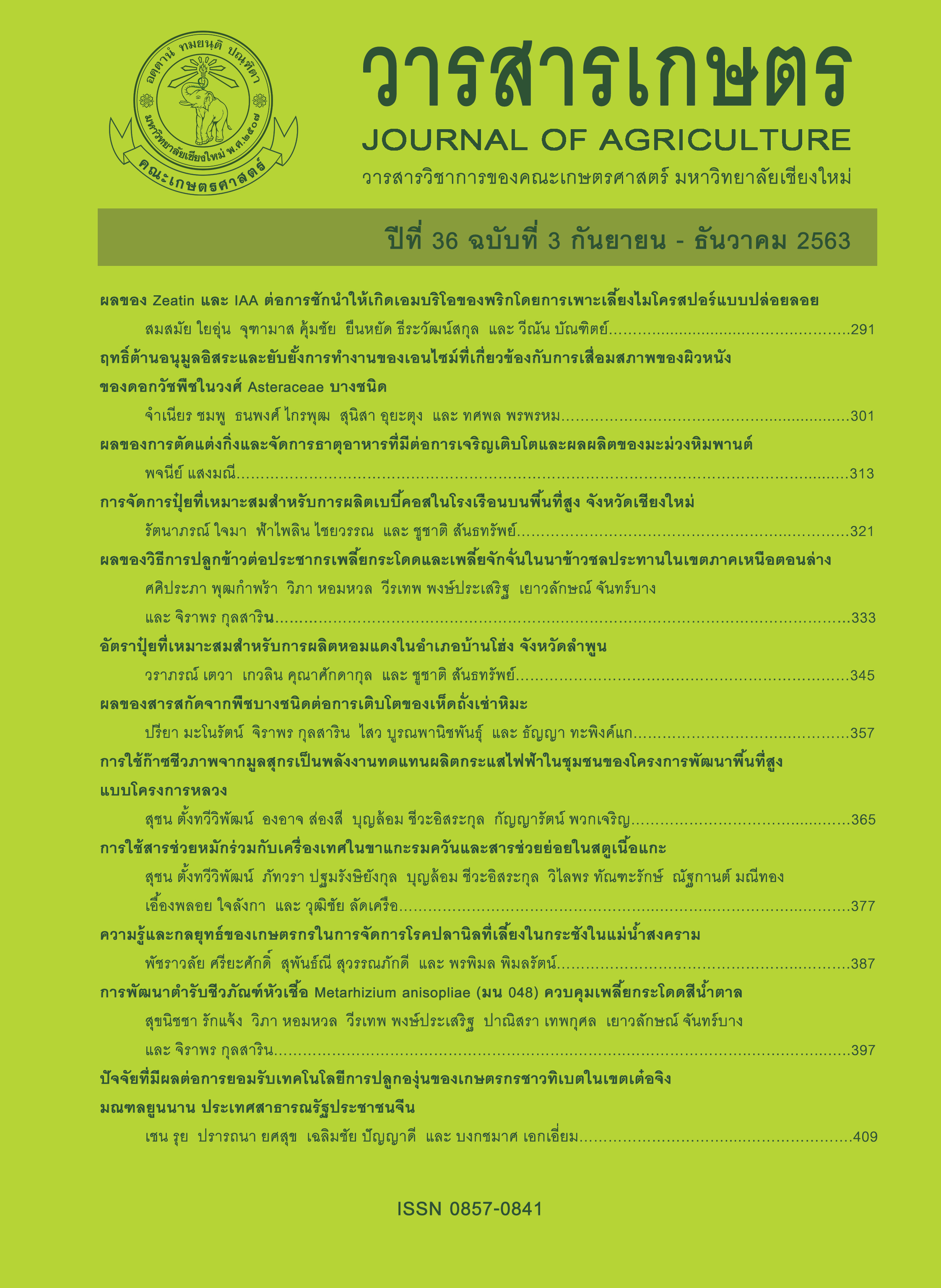ผลของสารสกัดจากพืชบางชนิดต่อการเติบโตของเห็ดถั่งเช่าหิมะ
Main Article Content
บทคัดย่อ
ไหม (Bombyx mori) เป็นแมลงสำคัญทางเศรษฐกิจที่สร้างรายได้ให้กับเกษตรกร ดักแด้ไหมมีส่วนประกอบของโปรตีน และสารอาหารที่มีประโยชน์หลายชนิด สามารถใช้เป็นวัสดุเพาะเลี้ยงเห็ดถั่งเช่าให้สรรพคุณเป็นยาสมุนไพรและมีประโยชน์ทางเวชสำอางได้ และพบว่าการใช้ฮอร์โมนพืชในกลุ่มของออกซิน มีส่วนช่วยในการสร้างก้านดอกเห็ดให้เติบโตได้ ดังนั้นในการวิจัยนี้จึงมีเป้าประสงค์เพื่อศึกษาประสิทธิภาพการใช้สารสกัดจากพืชต่อการเติบโตของเห็ดถั่งเช่าหิมะ (Cordyceps tenuipes) โดยทำการพ่นสารสกัดจากพืช ได้แก่ ถั่วงอก ข้าวโพดฝักอ่อน และ ฮอร์โมนเห็ด บนก้านดอกเห็ดถั่งเช่าหิมะเพาะเลี้ยงบนวัสดุเพาะข้าวขาวหอมมะลิ 105 ผสมดักแด้ไหม โดยพ่น 0.5 มิลลิลิตรต่อครั้งในระยะเวลาที่แตกต่างกัน พบว่า การพ่นสารสกัดถั่วงอก ในวันที่ 1, 4 และ 7 ใช้ปริมาณรวมทั้งหมด 1.5 มิลลิลิตรต่อขวดเพาะ เป็นวิธีการที่เหมาะสมสำหรับนำไปใช้ในการเร่งการเติบโตให้กับเห็ดถั่งเช่าหิมะ เมื่อทำการพ่นแล้วให้ ความสูงเฉลี่ยที่ 2.28 เซนติเมตร มีน้ำหนักก้านดอกเห็ดสดและแห้ง เท่ากับ 17.23 กรัมต่อขวดเพาะ และ 1.90 กรัมต่อขวดเพาะ นอกจากนี้ยังให้ปริมาณสาร adenosine ที่ 49.22 มิลลิกรัมต่อ 100 กรัม
Article Details
เอกสารอ้างอิง
Huang, L., Q. Li, Y. Chen, X. Wang and X. Zhou. 2009. Determination and analysis of cordycepin and adenosine in the products of Cordyceps spp. African Journal of Microbiology Research 3(12): 957-961.
Jarassamrit, N. 1994. Plant hormone and plant growth regulators. Sahamit Press, Bangkok. 124 p. (in Thai)
Ji, S.D., G.B. Sung, P.D. Kang, K.Y. Kim, Y.S. Choi, N.S. Kim, S.O. Woo, S.M. Han, I.P. Hong and N.G. Ha. 2011. Synnemata production using silkworm variety, female Yangwonjam by Isaria tenuipes. Mycobiology 39(3): 158-163.
Kepler, R.M., J.J. Luangsa-ard, N.L. Hywel-Jones, C.A. Quandt, G.H. Sung, S.A. Rehner, M.C. Aime, T.W. Henkel, T. Sanjuan, R. Zare, M.J. Chen, Z.Z. Li, A.Y. Rossman, J.W. Spatafora and B. Shrestha. 2017. A phylogenetically-based nomenclature for Cordycipitaceae (Hypocreales). International Mycological Association Fungus 8(2): 335-353.
Konala, N., P. Abburi, V.R. Bovilla and A. Mamillapalli. 2013. The effect of bovine milk on the growth of Bombyx mori. Journal of Insect Science 13: 98, doi: 10.1673/031.013.9801.
Liengpornpan, S. 2007. How does insect eating affect human being? Thaksin University Journal 10(2): 1-11. (in Thai)
Luerdara, K., J. Kulsarin, S. Buranapanichpan and T. Tapingkae. 2016. Growth of gold cordyceps (Cordyceps militaris) on pupae of Nanglai Thai native silkworm and eri silkworm. Journal of Agriculture 32(1): 95-102. (in Thai)
Manorat, P. 2015. Effect of mixed silkworm pupa culture media on growth and development of snowflake cordyceps (Isaria tenuipes). B.S. Special Problem. Faculty of Agriculture, Chiang Mai University, Chiang Mai. 26 p. (in Thai)
Ramachela, K. and S.M. Sihlangu. 2016. Effects of various hormonal treated plant substrates on development and yield of Pleurotus ostreatus. Cogent Food & Agriculture 2: 1, doi: 10.1080/23311932.2016.1276510.
Russell R. and M. Paterson. 2008. Cordyceps-a traditional Chinese medicine and another fungal therapeutic biofactory. Phytochemistry 69(7): 1469-1495.
Tapingkae, T. 2012. Cordyceps mushroom cultivation. Twofour Printing, Bangkok. 94 p. (in Thai)
Sun, Y.N., X.Y. Qin, Y.K. Lv, S.Z. Li and C. Wei. 2013. Simultaneous determination of five phytohormones in mungbean sprouts of China by micellar electrokinetic chromatography. Journal of Chromatographic Science 52(7): 1-5.
Wattanathorn, J. and S. Muchimapura. 2012. Silkworm pupae protect against Alzheimer’s disease. American Journal of Agricultural and Biological Sciences 7(3): 330-336.
Wen, T.C., G.R. Li, J.C. Kang, C. Kang and K.D. Hyde. 2014. Optimization of solid-state fermentation for fruiting body growth and cordycepin production by Cordyceps militaris. Chiang Mai Journal of Science 41(4): 858-872.
Wongsiri, S. 2012. Edible insects to be used as food during natural disasters. The Journal of the Royal Institute of Thailand 37(1): 125-139. (in Thai)


